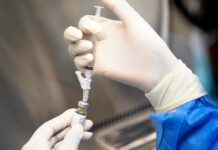Underlying all of that, the nation’s battle with the coronavirus is only intensifying.
People are still spreading the virus, getting sick from it and dying. There’s a massive and challenged effort to distribute the vaccine around the country. And models warn of many dark days ahead, as the winter winds on.
It’s a lot to keep track of. So here are some key pandemic-related numbers to know:
4,027 people in the United States died yesterday of covid-19.
It’s a grim new record for daily deaths in the nation. Back in the spring, when fatalities were surging in New York City, the daily death toll never exceeded 2,600.
365,346 people in the United States have died of covid-19 since the pandemic began.
That’s according to the latest count from the Johns Hopkins University pandemic dashboard. The total death toll is far higher than the 240,000 fatalities the White House estimated at the beginning of the pandemic.
5.9 million Americans have received the first dose of a coronavirus vaccine.
The true number could be somewhat higher, as there’s a lag in reporting. But one week into January, it’s still well below where federal officials had hoped.
Andrew Dunn, biotech reporter for Business Insider:
The idea has been for states to help distribute vaccine doses to health providers, who would then give it to their patients. But now hospitals say they need more support and guidance from the federal government if they are to have any hope of meeting goals.
“The slow pace of vaccine rollout has led to concern about whether the task of vaccinating all who are able to take the vaccine will happen as quickly as federal leaders have suggested it would,” the American Hospital Association wrote in a letter yesterday to Health and Human Services Secretary Alex Azar.
The hospitals are asking the Department of Health and Human Services for a number of actions, including more clarity around how to achieve vaccination goals, quick resolution of questions that arise, and better communication and coordination. Some hospitals have received far fewer vaccine doses than they requested, while others had excess shots even after they had vaccinated the highest-priority people.
“Currently, there are 64 disparate microplans developed by the states, a few large cities and other jurisdictions,” the letter says. “Has the Department of Health and Human Services assessed whether these plans, taken as a whole, are capable of achieving this level of vaccination?”
17.3 million coronavirus vaccine doses have been distributed.
Compared to getting shots in arms, the government has been faster at getting vaccine doses shipped out from Pfizer and Moderna, the only two companies with emergency use approval so far. But, as experts note, vaccines are only useful if they’re actually given to people.
405,000 to 438,000 people are projected to have died of the virus in the United States by Jan. 30.
This is according to a mash-up of models used by the Centers for Disease Control and Prevention. A team at the Massachusetts Institute of Technology developed a way to compare and merge more than two dozen different models from universities and analytics groups around the country (here’s our Health 202 about the ensemble model).
In recognition of the pitfalls in projecting deaths months into the future, the ensemble model only looks four weeks into the future.
59 percent: The share of coronavirus cases transmitted by people with no symptoms.
A majority of the time, the coronavirus is transferred from person to person with no apparent symptoms present, according to a model developed by CDC researchers.
The new findings strengthen the agency’s long-standing contention that asymptomatic people play a major role in spreading the virus — and underscore its advice for people to wear masks and socially distance even if they don’t feel ill.
“Fifty-nine percent of all transmission came from people without symptoms, under the model’s baseline scenario,” Ben Guarino reports. “That includes 35 percent of new cases from people who infect others before they show symptoms and 24 percent that come from people who never develop symptoms at all.”
“The bottom line is controlling the covid-19 pandemic really is going to require controlling the silent pandemic of transmission from persons without symptoms,” Jay Butler, CDC deputy director for infectious diseases and a co-author of the study, told Ben.
Ahh, oof and ouch
AHH: Some scientists worry the riot at the Capitol will fuel coronavirus spread.
“The mob that stormed the Capitol on Wednesday did not just threaten the heart of American democracy. To scientists who watched dismayed as the scenes unfolded on television, the throngs of unmasked intruders who wandered through hallways and into private offices may also have transformed the riot into a super-spreader event,” the New York Times’s Apoorva Mandavilli reports.
Experts say that the risk of viral transmission increases exponentially indoors, and many of Trump’s supporters who entered the Capitol did not appear to be wearing masks or making any effort at social distancing. The fact that people were yelling and shouting could further spread the virus if even a few of those in the riot were infected, which is likely given current rates of spread.
“The Black Lives Matter protests in the summer raised similar concerns. But most were held outdoors, and greater numbers of participants seemed to be masked. Research afterward suggested these were not super-spreading events,” Apoorva writes. Plus, a highly contagious new variant of the coronavirus may make events like the Capitol riot even more risky now.
Members of Congress could have been exposed.
Some 400 lawmakers and staff member huddled in a committee room where social distancing quickly became difficult during the riot. Rep. Susan Wild (D-Pa.) said that at least a dozen people refused to wear masks in the crowded room. At least one lawmaker who was cloistered in the Capitol chambers for much of Wednesday, found out that evening that he had tested positive for the coronavirus.
Rep. Jake LaTurner (R-Kan.):
OOF: New York front-line workers could lose their place in line if they skip shots.
Gov. Andrew M. Cuomo (D) has doubled down on his decision not to open vaccines to other vulnerable groups until all hospital workers, urgent-care providers and nursing home residents and staff get the shot, Bloomberg News’s Henry Goldman and Keshia Clukey report. Instead, he has sought to ramp up vaccinations among health-care workers by warning them that if they forgo a shot now they will lose their priority status once the vaccine rolls out to the general public.
About 30 percent of health workers have resisted getting a vaccine, either because they distrust the shot or because they believe they have immunity from a prior infection.
But officials around the state have said that the strict rules are hampering vaccine rollouts.
Mitchell Katz, chief executive officer of NYC Health and Hospitals, said that health officials in the city have thousands of vaccines in storage “without arms to give injections to.” These doses could go to patients over the age of 75 in public hospitals, who are the most at risk of severe illness or death if they get infected, he said.
The policy has led to a clash between Cuomo and New York City Mayor Bill De Blasio (D), who favors expanding eligibility.
Cuomo’s rule on front-line workers is the latest in a series of threats aimed at spurring vaccine distribution. Earlier this week he said that he would fine hospitals if they did not use up their coronavirus vaccine supplies fast enough.
OUCH: The U.S. paid a Texas company $70 million for ventilators that don’t work for covid-19 patients.
“This spring, amid a panic over a shortage of ventilators to treat the anticipated surge in coronavirus cases, the Pentagon announced the purchase of $84 million worth of breathing machines from four companies. One of the ventilators, the SAVe II+, made by a small Plano, Tex.-based company called AutoMedx, stood out from the rest,” The Post’s Reed Albergotti and Aaron Gregg report.
But a research study conducted by the Pentagon years earlier had found that the SAVe II device was unfit for a respiratory pandemic.
While soldiers on the battlefield are often young and fit and only need breathing support for a short time, virus victims with acute respiratory distress syndrome are often older and have more fragile lungs. They may require breathing support for weeks and months. The SAVe II ventilators were never developed to treat this type of patient population, and several emergency care experts have expressed that the devices don’t have the features necessary to support covid-19 patients.
It’s unclear why AutoMedx received the no-bid contract worth $70 million, or who precisely authored the deal. But the company had ties to the Trump administration. Adrian Urias, an AutoMedx co-founder and current shareholder, advised the Trump administration on coronavirus task force on ventilator purchases. AutoMedx’s current chief medical officer, Geoffrey Ling, reported to Adm. Brett Giroir, a physician who now serves as assistant secretary of health and human services, when they worked in the Pentagon’s research arm, the Defense Advanced Research Projects Agency, or DARPA.
Around the world
The United States isn’t the only country struggling with lagging vaccine distribution.
France has only distributed 45,000 doses of the Pfizer-BioNTech vaccine, compared with more than 417,000 in Germany. The slow rollout is not completely an accident. Officials had set up multiple layers of bureaucratic precautions in an attempt to assuage widespread concerns about the vaccine — 60 percent of adults in France cay they are disinclined to get the shot, compared with 30 percent in the United State, The Post’s Rick Noak reports.
The French government announced this week that officials intend to simplify the process, although they still plan to move forward with plans to form a vaccine council of 35 ordinary French citizens. While government officials have framed this as a way to reflect public concerns, some critics think it could provide a stage for conspiracy theories.
Israel, on the other hand, is vaccinating so quickly that it is running out of doses. Whereas the U.S. vaccination rate hovered around 1 percent at the beginning of this week, Israel had reached 12 percent of residents with an initial dose, the highest proportion of any country, The Post’s Steve Hendrix and Shira Rubin report. Israel’s rapid vaccine push, however, does not include almost 5 million Palestinians under its control in the occupied West Bank and the blockaded Gaza Strip. The country has rejected claims from human rights groups that it is obliged to provide vaccinations to Palestinians in the territories.
Meanwhile, more vaccines are coming on to the scene, giving countries much-needed resources in the desperate race to control the virus. The European Union’s executive commission approved Moderna’s coronavirus vaccine this week, paving the way for its rollout in the 27-nation bloc.
And a Brazilian research institute found that a vaccine made by Beijing-based Sinovac appears to have an efficacy rate of 78 percent. The Chinese government has also approved another vaccine made by the state-owned company Sinopharm. Both Chinese vaccines provoke an immune response using inactivated virus. While they tend to have lower efficacy rates compared to the mRNA-based vaccines from Pfizer and Moderna, they are easier to transport and store, which could make them particularly valuable in developing countries that lack the infrastructure for ultracold storage.
Elsewhere in health care
Illinois became the first state to provide public health insurance to undocumented seniors.
Illinois was also the first state to provide insurance for undocumented children, a policy that a handful of other states have since adopted. In 2019, California opened its Medi-Cal program to all low-income residents under the age of 26.
A group of Illinois health-care advocates had pushed for coverage for all low-income undocumented residents, but the legislature opted for a smaller program. It will cover low-income people 65 and older who are undocumented or have been legal permanent residents for less than five years, and are therefore not otherwise eligible for government health care.
The program will initially be small but is expected to expand as the state’s demographics shift. The number of undocumented immigrants in Illinois is expected to grow rapidly over the next decade, from about 3,986 seniors to 55,144 by 2030.








